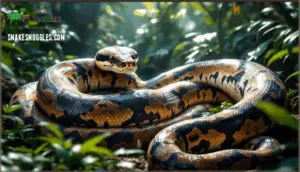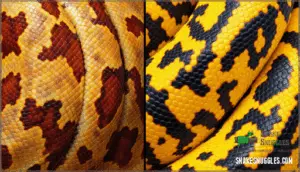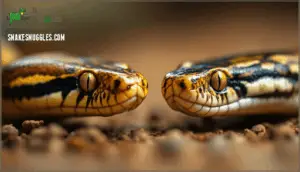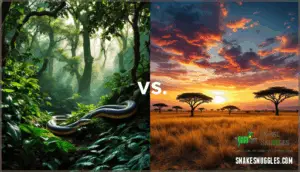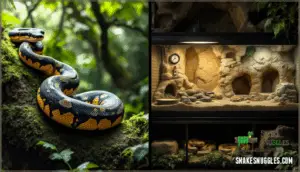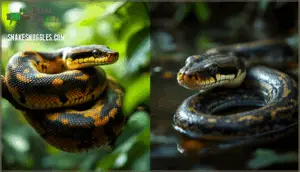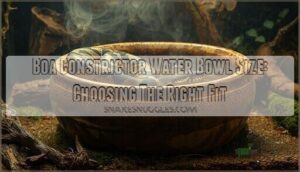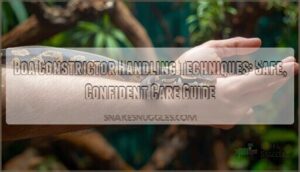This site is supported by our readers. We may earn a commission, at no cost to you, if you purchase through links.
 When you peer into a terrarium and see a massive snake coiled around a branch, the question that probably crosses your mind is whether you’re looking at a boa constrictor or a python. These two giants of the snake world share enough similarities to confuse even experienced reptile enthusiasts, yet they’re more different than most people realize.
When you peer into a terrarium and see a massive snake coiled around a branch, the question that probably crosses your mind is whether you’re looking at a boa constrictor or a python. These two giants of the snake world share enough similarities to confuse even experienced reptile enthusiasts, yet they’re more different than most people realize.
Split apart by roughly 50 million years of evolution on opposite sides of the planet, boas and pythons developed distinct anatomies, reproductive strategies, and survival tactics. Understanding these differences matters whether you’re considering a pet snake, studying herpetology, or simply want to know what you’re looking at during your next zoo visit.
The distinctions go far beyond size—they’re written in their bones, their birthplaces, and even how they bring new snakes into the world.
Table Of Contents
- Key Takeaways
- Boa Constrictor Vs Python: Key Differences
- Physical Appearance and Size Comparison
- Habitat and Geographic Range
- Behavior, Temperament, and Care Needs
- Choosing Between a Boa or Python as a Pet
- Frequently Asked Questions (FAQs)
- What are the differences between a Boa vs. a Python?
- Does a boa or Python make a better pet?
- What is the difference between a Python and a constrictor?
- What is the difference between a python and a boa constrictor?
- Which is more aggressive, python or boa?
- Who would win boa vs python?
- Is python a constrictor?
- What do boa constrictors eat in the wild?
- How do pythons hunt for their prey?
- What is the lifespan of pythons and boas?
- Conclusion
Key Takeaways
- Boas and pythons split evolutionarily about 50 million years ago into separate families (Boidae and Pythonidae), with boas inhabiting the Americas and pythons living in Africa, Asia, and Australia—meaning these snake groups never naturally overlap in the wild.
- The most striking reproductive difference is that pythons lay eggs externally (oviparous) while boas give live birth after developing eggs internally (ovoviviparous), which affects their breeding behavior and offspring survival strategies.
- Pythons possess more skull bones, including supraorbital bones and heat-sensing pits between their lip scales for detecting warm-blooded prey, while most boa constrictors lack these specialized heat pits and have fewer head bones overall.
- Both snakes make manageable pets with 20-30 year lifespans in captivity, though pythons generally require more precise environmental controls and larger enclosures, while boas tend to be hardier and better suited for beginners.
Boa Constrictor Vs Python: Key Differences
At first glance, boas and pythons look like they could be cousins at a family reunion. But dig a little deeper, and you’ll find some surprising differences that set these two constrictors apart.
Let’s break down what makes each snake unique, from the inside out.
Family and Species Classification
You’ll find boa constrictors and pythons separated into distinct families despite their similar lifestyles. Boa constrictors belong to Boidae, while pythons fall under Pythonidae, a split that happened roughly 50 million years ago. This Snake Family Classification reflects deep genetic differences between these constrictors. Pythons also have more head bones than boas.
The Genus Comparison reveals further diversity. Within Boa, you’ll encounter three main species: Boa constrictor, Boa imperator, and Boa sigma. The genus Python contains 11 recognized species, including Python regius and Python reticulatus. Subspecies Identification can be tricky—Boa constrictor alone has at least 8 recognized subspecies, though Taxonomic Update continues to hone these classifications.
| Feature | Boidae | Pythonidae |
|---|---|---|
| Number of Genera | ~13 genera | 10 genera |
| Total Species | ~43 species | 40+ species |
| Geographic Origin | New World (Americas) | Old World (Africa, Asia, Australia) |
Hybridization Effects complicate matters in the pet trade, where most captive snakes are genetic mixes. Conservation Status varies widely—some boa constrictor subspecies are federally threatened or endangered in the US, while python species range from Least Concern to Vulnerable on the IUCN Red List.
Physical and Anatomical Differences
Beyond family trees, you can distinguish boas and pythons by examining their skulls, sensory organs, and body proportions. Physical differences in snake anatomy reveal that pythons possess supraorbital bones, which are absent in boas, resulting in pythons having more bones overall in their skeletal structure. Scale morphology differs subtly between families, though both share similar muscular systems for constriction. Tail length proportions and organ placement also vary—pythons commonly have shorter, more abrupt tapers.
| Feature | Boa Constrictors | Pythons |
|---|---|---|
| Supraorbital Bones | Absent | Present |
| Heat-Sensing Pits | Only in some species (not B. constrictor) | Present between lip scales |
| Premaxillary Teeth | Present | Absent |
| Vestigial Spurs | Smaller, less prominent | Larger, more visible |
| Skull Bones | Fewer overall | More bones in head |
Geographic Distribution Differences
Geographic distribution clearly separates these snake families. Boa constrictors and related native boa ranges span the New World—from northern Mexico through Central America into South America, reaching Argentina. Pythons inhabit Old World regions: sub-Saharan Africa, Southeast Asia, and Australia. You won’t find habitat overlap between these families since their geographical distribution of snakes reflects millions of years of isolated evolution.
Boa constrictors use their sharp, curved teeth to secure prey. Climate factors like tropical warmth and humidity shape both python habitats and snake habitats across their respective continents, influencing conservation impact today.
| Snake Family | Geographic Distribution |
|---|---|
| Boa Constrictors | North and South America (Mexico to Argentina) |
| Pythons | Africa, Asia, and Australia |
| Habitat Overlap | None—completely separate ranges |
| Climate Preference | Both favor tropical/subtropical regions |
Reproductive Methods and Lifespan
Once you understand where these snakes live, you’ll notice that their reproductive methods separate them just as clearly. Pythons are oviparous, laying hardened eggs that hatch externally, while boas are ovoviviparous, developing eggs internally before giving birth to live young. This difference in reproduction affects incubation behavior and hatchling survival rates.
Pythons lay eggs externally while boas give live birth—a fundamental reproductive divide that defines these constrictor families
Both families share similar lifespan factors, with reproductive cycles influenced by environmental conditions and species-specific biology.
| Reproductive Feature | Boa Constrictors | Pythons |
|---|---|---|
| Reproductive Method | Ovoviviparous (live birth) | Oviparous (egg-laying) |
| Incubation | Internal development in female’s body | External eggs, often brooded by coiling |
| Lifespan | Up to 30 years in captivity | Up to 30 years in captivity |
Physical Appearance and Size Comparison
When you place a boa constrictor and a python side by side, you’ll notice they’re built quite differently despite both being powerful constrictors. Size variations between these snakes can be dramatic, and their physical features tell you a lot about how they’ve adapted to their environments.
Let’s look at the specific ways their appearances set them apart.
Size and Weight Ranges
When comparing boa constrictors and pythons, size is often the most striking difference. Some python species significantly surpass their boa cousins in length, with the reticulated python reaching up to 10 meters, while boa constrictors typically max out around 3 meters. Sexual dimorphism is another notable factor, with females generally outweighing males in both groups.
| Characteristic | Boa Constrictors | Pythons |
|---|---|---|
| Maximum Length | 3-4 meters | 3-10 meters (species-dependent) |
| Average Weight | 10-30 kg | 20-90 kg (varies widely) |
| Growth Rate | Moderate, steady | Faster in larger species |
| Sexual Dimorphism | Females larger | Females considerably larger |
| Size Variations | Relatively consistent | Extreme variation across species |
Color Patterns and Markings
Think of it this way: while size matters, the skin tells the real story—and regarding patterns and colors, these two snake families paint very different pictures on their scales. Boa colors lean toward earthy reds and browns with saddle-shaped markings, while python patterns display more geometric shapes with sharper contrast. Regional variations play a huge role in camouflage significance—each snake’s appearance reflects its native habitat.
| Feature | Boa Constrictors | Pythons |
|---|---|---|
| Base Colors | Browns, reds, tans | Yellows, blacks, browns |
| Pattern Type | Saddle-shaped blotches | Geometric, chain-like |
| Contrast Level | Moderate | Often high |
| Regional Variation | Moderate across range | Extreme species diversity |
| Camouflage Function | Forest floor blending | Habitat-specific mimicry |
Distinctive Features (Spurs, Heat-Sensing Pits)
Beyond the obvious visual differences, you’ll find that boas and pythons carry subtle evolutionary badges—remnants of their ancient past and specialized hunting tools that set them apart in fascinating ways. Both snakes possess vestigial spurs near their cloaca, tiny claw-like projections that hint at their evolutionary significance as remnants of ancestral legs. The real anatomical variations emerge with heat-sensing pits: pythons have heat pits positioned between their lip scales, allowing precise thermal detection of warm-blooded prey, while most boa constrictors lack this specialized equipment entirely.
| Feature | Boa Constrictors | Pythons |
|---|---|---|
| Vestigial Spurs | Present near cloaca | Present near cloaca |
| Heat-Sensing Pits | Absent (most species) | Present between lip scales |
| Scale Morphology | Smooth head scales | More fragmented head bones |
Habitat and Geographic Range
Where these snakes live tells you a lot about how they’ve adapted over millions of years. Boas call the Americas home, while pythons spread across Africa, Asia, and Australia—meaning you won’t find them crossing paths in the wild.
Let’s look at the specific regions where each snake thrives and what makes their habitats so different.
Boa Constrictor Habitats
You’ll find boa constrictors thriving across a surprisingly diverse range of environments, from the steamy rainforests of Central and South America to the dry scrublands and even rocky hillsides stretching from northern Mexico down to Argentina.
These adaptable snakes prefer warm climates with high humidity, though regional variations exist based on prey availability.
Unfortunately, habitat destruction threatens many populations, making conservation efforts essential for their survival across their geographical distribution.
Python Habitats
Pythons dominate the Old World tropics, carving out territories across sub-Saharan Africa, Southeast Asia, and Australia, where their adeptness at swimming lets them thrive near rivers, swamps, and other water sources that boas usually avoid.
These python characteristics allow them to occupy diverse snake habitats across three continents:
- African habitats feature savanna woodlands and tropical forests
- Asian habitats span from humid rainforests to agricultural regions
- Australian habitats include coastal wetlands and grasslands
Unfortunately, habitat destruction across their geographic distribution threatens many populations, making conservation efforts critical for protecting these Old World specialists.
Overlapping and Unique Geographic Regions
Despite their striking similarities, these two ancient serpents inhabit separate realms on Earth’s map—boas rule the New World while pythons stake their claim across the Old World, with virtually no territorial overlap between them. This geographic distribution of snakes reflects millions of years of isolated evolution, where climate factors and regional biodiversity shaped each group’s adaptations. You won’t find pythons naturally slithering through Amazon rainforests, just as boas never colonized African savannas.
However, invasive species like Burmese pythons in Florida’s Everglades now blur these ancient boundaries, challenging conservation efforts to protect native snake habitats.
Behavior, Temperament, and Care Needs
Understanding how boas and pythons behave—and what they need to thrive—makes all the difference when you’re caring for these snakes. Their temperaments, feeding habits, and health concerns vary in ways that directly affect their suitability as pets.
Let’s break down what sets them apart regarding daily behavior and long-term care.
Activity Levels and Social Behavior
When you’re considering these snakes as pets, understanding their daily rhythms and social tendencies can make all the difference in creating a comfortable home for them. Both species exhibit solitary behavior in the wild, rarely seeking social interactions except during breeding season. Snake temperament varies between the two:
- Boas show stronger arboreal tendencies, often climbing and resting on elevated perches, while pythons tend to be more terrestrial
- Diurnal activity patterns differ, with pythons usually more active during dawn and dusk for hunting strategies
- Constricting snake behavior remains similar, though behavioral differences emerge in how they respond to interaction and environmental changes
Snake behavior and snake temperament depend largely on individual personality and consistent, gentle interaction with you.
Dietary Needs and Feeding Habits
Both boas and pythons are carnivores that hunt using similar constriction methods, but their feeding schedules and prey preferences shift as they grow from juveniles into full-sized adults.
You’ll feed younger snakes more frequently, about once every five to seven days, while adults need meals every two to four weeks.
In the wild, both species consume warmblooded prey like rodents, birds, and small mammals, with prey size matching the snake’s girth. Captive diets usually consist of appropriately sized frozen-thawed rodents to meet their nutritional needs.
Health Issues and Longevity
Keeping your snake healthy means understanding their unique vulnerabilities. Boa constrictors and pythons face different health risks that directly affect how long they’ll be part of your life.
IBD susceptibility varies dramatically between these reptiles:
- Pythons develop neurological symptoms from Inclusion Body Disease within 60 days, while boas can carry high viral loads for over two years without showing signs
- Captivity longevity reaches 20-30 years for both species with proper husbandry—that’s 10-15 years longer than their wild counterparts
- Husbandry impact determines whether your snake thrives or struggles, as obesity, dehydration, and respiratory infections stem from subpar care
Species lifespans and viral response patterns mean pythons need closer health monitoring than boas, making your choice a long-term commitment shaped by snake characteristics and reptile behavior understanding.
Choosing Between a Boa or Python as a Pet
Deciding which snake fits your lifestyle depends on understanding what each species brings to the table. Boas and pythons share similarities, but their differences in size, temperament, and care requirements can make one a better match for you than the other.
Let’s break down what owning each type really involves.
Boa Constrictor as a Pet
If you’ve ever imagined a pet that combines ancient mystique with surprisingly manageable care, a boa constrictor might just be your answer. These snakes display a calm temperament that makes interaction techniques straightforward for beginners.
You’ll need an enclosure size of at least six feet for adults, with a feeding schedule of appropriately sized prey every one to two weeks. Boa constrictors rarely show aggression, and their health concerns are minimal with proper husbandry, making them surprisingly approachable companions.
Python as a Pet
Choosing a python as your companion means welcoming a snake that’s often larger, more aquatic in nature, and requires a bit more space than its New World cousin. Ball pythons make excellent beginner pythons due to their docile snake temperament and behavior, while Burmese python species demand much larger enclosure needs.
You’ll follow a feeding schedule similar to boas, but care techniques require extra care with arboreal species that prefer climbing enrichment.
Considerations for Prospective Snake Owners
Before bringing home either species, you need to evaluate initial costs—usually $100 to $500 for the snake plus enclosure setup—and legal restrictions in your area.
Your long-term commitment spans 20 to 30 years, so consider future housing changes and health concerns like respiratory infections from poor husbandry.
Always prioritize ethical sourcing through captive breeders who document lineage, making sure your boa constrictors or pythons match their natural snake characteristics, behavior, and habitat needs.
Frequently Asked Questions (FAQs)
What are the differences between a Boa vs. a Python?
These massive constrictors split along the branches of their evolutionary history millions of years ago. Boas belong to Boidae, while pythons claim Pythonidae—a skeletal anatomy distinction that shapes everything from where they live to how they bring offspring into the world.
Does a boa or Python make a better pet?
Your choice depends on owner experience and care difficulty. Boa constrictors generally tolerate more, tolerate varied conditions better, and suit beginners.
Pythons need precise enclosure size, stricter humidity control, and reward experienced keepers with impressive size diversity.
What is the difference between a Python and a constrictor?
Constrictor" describes the killing method—squeezing prey until suffocation—used by many snake species. Pythons are constrictors, but they’re distinct from boa constrictors through evolutionary divergence, skeletal structure, reproductive methods, and geographic origins, making constrictor snakes a broader category than a single species.
What is the difference between a python and a boa constrictor?
These serpentine cousins share striking similarities yet diverge in fascinating ways. Pythons and boa constrictors differ primarily in their family classification, reproductive methods, and geographic origins.
Pythons are oviparous egg-layers from the Old World, while boas give live birth and inhabit the Americas, reflecting distinct evolutionary paths.
Which is more aggressive, python or boa?
Neither snake is truly aggressive by nature. Both pythons and boa constrictors often avoid confrontation unless they feel threatened.
Defensive behaviors like hissing or striking occur when they perceive a threat, but these reactions depend more on individual temperament and how they’re treated than species differences.
Who would win boa vs python?
Two snakes in the wild rarely duel head-to-head, but when size advantage and constriction strength align, the larger python often overpowers the boa.
Environment factors and bite force matter less than sheer mass in this showdown.
Is python a constrictor?
Yes, pythons are constrictors. They use constriction as their primary hunting strategy, coiling around prey and applying pressure to cause suffocation.
This constriction mechanism evolved through evolutionary pressures, making pythons efficient predators without venom, relying instead on bite force and muscular strength.
What do boa constrictors eat in the wild?
Boa constrictors hunt warm-blooded prey like birds, rodents, and small mammals in the wild. Prey size varies by the snake’s age and body length, with adults consuming larger animals.
Hunting strategies involve ambush techniques, striking quickly before constricting.
How do pythons hunt for their prey?
Pythons rely on ambush predation, using specialized heat pits to detect warm-blooded prey in darkness.
These hunting adaptations allow precise prey detection before striking and employing their constriction method to subdue meals efficiently.
What is the lifespan of pythons and boas?
In the wild, lifespan factors like predation and habitat loss limit most species to 20 to 25 years, but captivity impact changes everything.
With proper care, both snake species comparison shows pythons and boas routinely reach 30 years or more, demonstrating considerable aging process stability.
Conclusion
Like Darwin’s finches adapting to separate islands, boas and pythons followed divergent evolutionary paths across continents. Whether you’re weighing the boa constrictor vs python as a potential pet or simply appreciating these notable constrictors, remember that each species represents millions of years of specialized adaptation.
Your choice between them isn’t just about preference—it’s about matching their distinct needs with your capabilities. These ancient serpents deserve informed guardianship that honors their unique biology, temperament, and care requirements.
- https://a-z-animals.com/animals/comparison/boa-vs-python-how-to-tell-them-apart/
- https://www.eddmaps.org/species/subject.cfm?sub=18348
- https://en.wikipedia.org/wiki/Python_(genus)
- https://www.worldatlas.com/articles/how-many-types-of-pythons-live-in-the-world-today.html
- https://www.boa-constrictors.com/en/Interesting_facts_about_Boa_constrictor/Boa_constrictor_Care/diseases/Inclusion_Body_Disease

